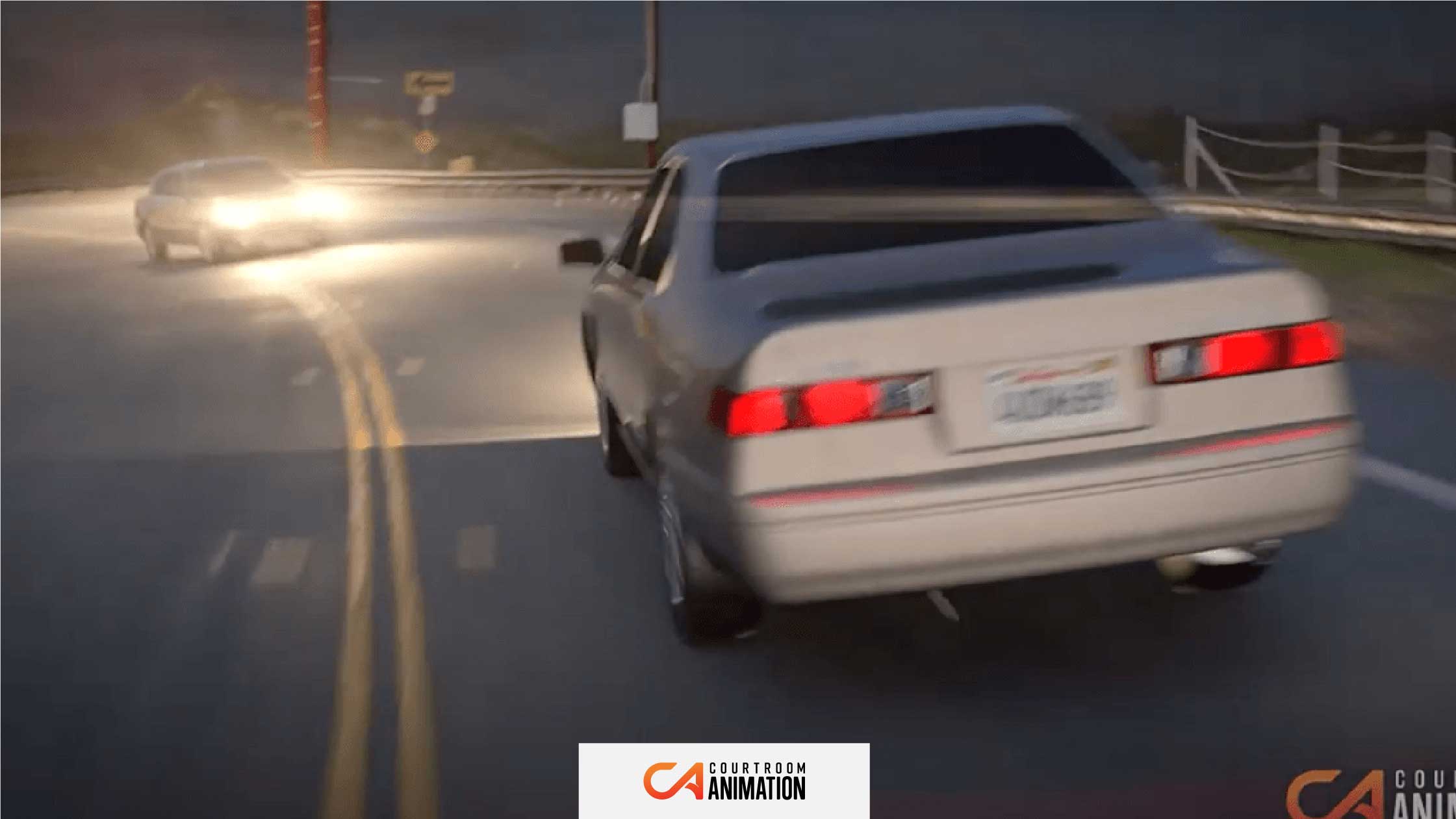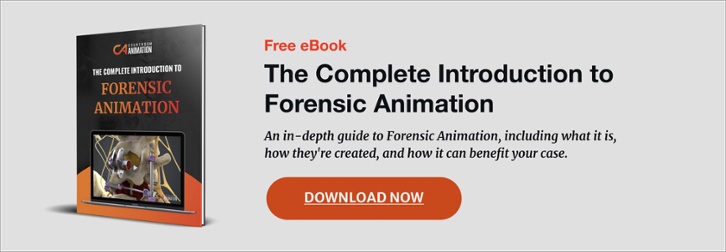
How can you put a jury or other parties at the scene of any motor vehicle collision? One way is with a motor vehicle collision animation.
Motor vehicle collision cases, like most cases, aren’t typically cut and dry. They’re often difficult to verbally explain and include many factors. With multiple perspectives from witnesses and those involved, it can be hard for a jury to follow the story and reach your desired conclusion.
But that’s where a highly accurate, 3D animation can provide support. To maximize accuracy, animators travel to the scene of the collision to collect data and accurately recreate the event, so that jurors and other viewers can objectively evaluate what happened from multiple perspectives.
Let’s take an in-depth look at how we achieve this.
Right Way, Wrong Way
It’s one thing to create a graphic that depicts how a vehicle collision happened. It’s another to be able to recreate the various scenarios that could, or should have, occurred had one person acted in a different way.
If you’re representing the plaintiff, you can for example show what could have happened if one driver had made a more reasonable decision, like attempting to stop at a yellow light or yielding at a right turn at a stoplight. Being able to show alternative scenarios is a powerful tool in court because it can encourage a jury to view the collision in a different light.
Alternatively, if you represent the defense, this can be useful to disprove a witness or driver’s testimony by providing animation that shows their account of the collision couldn’t be true, based on scientific variables.
Perspectives (Drivers & Witnesses)
Forensic animation, because it is scientifically created, has the ability to validate or invalidate different driver and witness perspectives. When a collision is witnessed by multiple perspectives and angles, there are often conflicting accounts. By collecting the evidence and applying all of the witness accounts, animation can find a general concord between them.
Witnesses are often confident in their recollection of an event, but human memory and visual perception tend to be unreliable, which is why there are so many narratives in a collision case. Animation can help mitigate any conflicting viewpoints or opposing narratives, further solidifying your case.
You’ll notice in this animation above that both the driver and the witness perspectives are depicted. Both perspectives prove that the driver went over the dividing line, and both perspectives show how little time the driver had to react.
The jury had confidence this animation was accurate because the animator team worked with accident reconstruction experts, laser scan data, vehicle dynamics data, and location-based nighttime photography to create these highly realistic and accurate depictions of the collision. This particular exhibit proved extremely useful in delivering a successful result for the client.
Motor Vehicle Collision Injuries
Unfortunately, injuries are an all too common occurrence in motor vehicle collision incidents. However, the good part is that animation can validate or invalidate injuries sustained during the crash. If someone had an injury before an accident and tried to blame the collision for it, animation could easily disprove that the collision was the culprit. In contrast, it can also prove that the collision caused the injury.
Validating Injuries for Plaintiffs
Take this animation video, for example. This motorcyclist was injured by a driver that made an illegal left-hand turn:
You can see how the animation shows the severity of the impact, focusing on the mechanism of injury for the forearm fractures. Furthermore, our team created highly realistic exhibits showcasing the open reduction surgeries to address the forearm fractures. These surgical animations allow jurors to see the severity of an operation, which can further demonstrate the impact of the collision.
Here is another plaintiff we supported that sustained a multitude of head and face injuries following a motor vehicle collision:
Courtroom Animation was able to create one cohesive animation that depicted all of the injuries in a realistic and accurate way. This involved the use of radiology images and multiple expert reports to convey these injuries.
Demonstrating Lack of Fault for Injuries for Defendants
Additionally, our team is also adept at creating animations to support defense’s motor collision cases. In this one unfortunate case, the plaintiff’s client was killed from a collision with a turning box truck.
Through the use of 3D animation, we were able to depict an alternative scenario, showing what would have happened if the motorcyclist had slowed down instead of speeding up. This video helped validate that the defense had no fault in this case.
Data Visualizations
Motor vehicle collision animations are highly accurate recreations based on 3D laser scans of the road surface, vehicles, and environment, ensuring a solid foundation and admissibility. Visualization can even demonstrate signs, infrastructure, or other environmental changes that have occurred since the collision took place.
This is made possible by combining different data sets to tell a complete narrative of the event. Those data points include:
● Laser scans
● Aerial footage
● Satellite imagery
● Dash camera and other surveillance footage
3D laser scans, in particular, are a great way to collect hundreds of millions of data points that are accurate to the millimeter.
Take this image above, for example. This is a laser scan of the scene of an event. While you can make out trees, roads, and buildings, the image itself is difficult for most people to digest. Using the data points collected in this scan, 3D models can start to be created. These are much easier to see than the laser scan.
These accurate 3D models are layered on top of the scan, providing physical properties to the various objects. Here you can see the scene start to take shape with a solid environment that has a strong foundation. Everything is highly accurate to the real world. This is a tried and true way of recreating an environment.
From there, the remaining building blocks can be added, including textures, materials, colors, lighting, and more to create a realistic environment. This is the foundation of these 3D models and how they are created. After that, the data set that the expert witness provides is imported into the model to recreate the scene.
The Bottom Line
Motor vehicle collision animation is a persuasive and accurate way to show your audience exactly how an accident occurred. Exhibits that animate the mechanism of injury help make jurors more sympathetic to your client’s injuries, or on the other hand, help disprove false claims.
Whatever your case — trucking, motorcycle, maritime, aviation, drunk driving, multi-vehicle collisions, or some other kind of collision. Courtroom Animation has the expertise and experience to create an influential animation. If you need support for motor vehicle collision animation, get a quote today!

Topics: